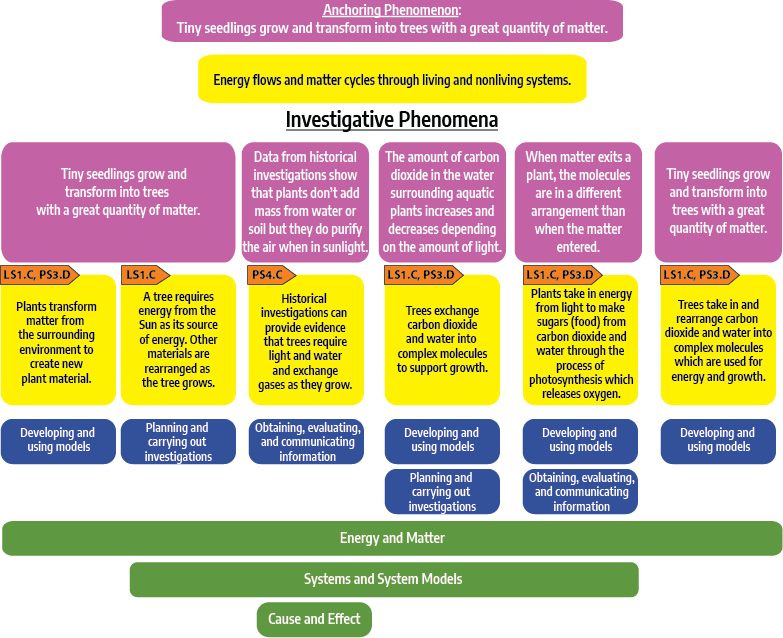
This unit builds around the idea that energy flows and matter cycles through living systems. The anchoring phenomenon for the unit is a time-lapse animated video of a seedling growing into a tree. This phenomenon leads students to ask, “Where does it come from?” Students investigate the energy flow and matter cycling in a seedling as it gathers matter through chemical reactions to grow into a large oak tree.
Prior to this unit, students would already have had some middle-school-level instruction in physical science. Specifically, students would enter this lesson after completing units related to DCI PS1.A (Matter is composed of atoms and molecules can be used to explain the properties of substances, diversity of materials, states of matter, phase changes, and conservation of matter) and PS1.B (Reacting substances rearrange to form different molecules, but the number of atoms is conserved. Some reactions release energy and others absorb energy).
Students will have had middle-school-level instruction on some portions of PS3.B (The relationship between the temperature and the total energy of a system depends on the types, states, and amounts of matter) in grade 6. Other aspects of PS3.B (Kinetic energy can be distinguished from the various forms of potential energy and is proportional to the mass of the moving object and grows with the square of the speed) will be explored in grade 8 This unit focuses on a small component of PS3.B (Energy changes to and from each type can be tracked through physical or chemical interactions).
Students would have had instruction in LS1.A (All living things are made up of cells. In organisms, cells work together to form tissues and organs that are specialized for particular body functions.) Students will extend their learning about energy and matter flow within a single tree to the cycling of atoms between living and nonliving parts of an ecosystem and how matter and energy are transferred between organisms within an ecosystem (LS2.B) in later units in grade 7.
The Performance Expectation that is addressed in this unit is:
| MS-LS1-6 | Construct a scientific explanation based on evidence for the role of photosynthesis in the cycling of matter and flow of energy into and out of organisms. |
|---|

The Learning Sequence Narrative briefly describes what students do in each lesson and links the learning between the lessons as a conceptual storyline. At the end of each learning sequence, students make connections to their understanding of the investigative phenomenon (and to the anchoring phenomenon if appropriate).
The anchoring phenomenon of a seedling growing into a larger tree is used throughout the learning sequence.
Anchoring Phenomenon: Tiny seedlings grow and transform into trees with a great quantity of matter.
Students figure out this phenomenon by:
Planning and Carrying Out Investigations
Developing and Using Models
Constructing Explanations and Designing Solutions
Obtaining, Evaluating, and Communicating Information
Engaging in Argument from Evidence
LS1.C: Organization for Matter and Energy Flow in Organisms
PS3.D: Energy in Chemical Processes and Everyday Life
Cause and Effect
Energy and Matter
Systems and System Models
The following Learning Sequence Narrative is based on the conceptual flow concept map above.
In this lesson, students will observe a time-lapse video of a seedling growing into a large tree to develop an initial model to explain how plants transform matter from the surrounding environment to create new plant material.
This lesson follows Lesson 1: Tree Matter where students modeled their thinking of where the matter that makes up a tree comes from. The students build on their thinking by planning an investigation to test where the matter of a tree comes from. The students will not carry out the investigation but will connect their own plan to historical scientific investigations.
In this lesson, students will obtain information about historical investigations that lead to an understanding that plants change the composition of air. In the next lesson, students will carry out an investigation to gain evidence that a gas exchange is involved when plants gain matter (live and grow).
In this lesson, students will build on the learnings from the previous lesson that plants need sunlight to add mass, but soil and water are not part of the additional mass. In this lesson, students investigate the gases that are exchanged within the plant.
In this lesson, students will think about what is accumulated in the plant due to photosynthesis. Students use candy and toothpicks to model the creation of glucose and cellulose through chemical processes.
This is the final lesson of the sequence. Students will revise their initial models from the Lesson 1: Tree Matter and apply the learning they gained from the previous lessons.
Only SEPs that have a strong progression are detailed here. While other SEPs are included in the sequence and important to the lesson in which they are used, if they do not appear in multiple lessons, they are not outlined here.
Susan Gomez Zwiep: Professor/Regional Director, CSULB/K-12 Alliance @ WestEd Philip Hudec: Teacher on Special Assignment: Secondary Science/Project Director, Palm Springs Unified School District Brenda Mueller: Middle School Science Teacher, San Diego Unified School District
Sharon Schmidt, First Grade Teacher, San Diego Unified SD Nina Mcgroaty, Galt Joint Union School District
Achieve Science Peer Review Panel

A Collaboration of the K-12 Alliance @ WestEd, Aspire Public Schools, Galt JUSD, High Tech High, Kings Canyon USD, Lakeside USD, Oakland USD, Palm Springs USD, San Diego USD, Tracy USD, Vista USD, Achieve, and the California Department of Education
with funding from the S.D. Bechtel, Jr. Foundation and Hastings-Quillin Fund
The California K–8 NGSS Early Implementation Initiative, developed by the K–12 Alliance at WestEd with close collaborative input on its design and objectives from the State Board of Education, the California Department of Education, and Achieve is a fast-start demonstration project to build local education agency (LEA) capacity to fully implement the Next Generation Science Standards (NGSS) as a core subject in the elementary grades (K–5) and as the SBE’s preferred integrated model in grades 6–8.
The four-year Initiative provides teachers and administrators with in-depth, content-rich professional development to build leadership capacity and teacher acumen to deliver high-quality 3-dimensional learning for K–8 students. In addition, through collaborations among the K–12 Alliance, Achieve, and others, the LEAs in the Collaborative have opportunities to pilot test new NGSS-aligned tools, processes, assessment item prototypes, and digital and other instructional materials. The LEAs serve as resources for NGSS implementation across California, and in other NGSS-adopting states as well.
Participants in the CA NGSS K–8 Early Implementation Initiative developed and field-tested the lessons in the learning sequence. The sequences were vetted by Science Peer Review Panel using Achieve’s EQuiP rubric for science and found to be aligned with the intent of the NGSS.
NGSS Lead States. 2013. Next Generation Science Standards: For States, By States. Washington, DC: The National Academies Press.
A Framework for K-12 Science Education: Practices, Crosscutting Concepts, and Core Ideas. DOI: https://doi.org/10.17226/13165. National Research Council; Division of Behavioral and Social Sciences and Education; Board on Science Education; Committee on a Conceptual Framework for New K–12 Science Education Standards. National Academies Press, Washington, DC.